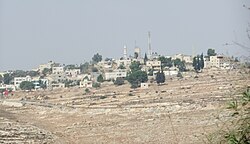Nabi Salih
| Nabi Salih | |
|---|---|
| Other transcription(s) | |
| • Arabic | النبي صالح |
| • Also spelled | an-Nabi Salih (official) Nabi Saleh (unofficial) |
 |
|
| Location of Nabi Salih within the Palestinian territories | |
| Coordinates: 32°01′0″N 35°7′29″E / 32.01667°N 35.12472°ECoordinates: 32°01′0″N 35°7′29″E / 32.01667°N 35.12472°E | |
| Palestine grid | 161/158 |
| Governorate | Ramallah & al-Bireh |
| Government | |
| • Type | Local Development Committee |
| Area | |
| • Jurisdiction | 2,797 (in 1,945) dunams (2.8 km2 or 1.1 sq mi) |
| Population (2007) | |
| • Jurisdiction | 534 |
| Name meaning | "The Prophet Salih" |
Nabi Salih (Arabic: النبي صالح) is a small Palestinian village in the Ramallah and al-Bireh Governorate in the central West Bank, located 20 kilometers northwest of Ramallah. It has a population (2016) of 600. It is noted for the weekly marches to protest the occupation undertaken since 2010, a practice suspended in 2016, after 350 villagers were estimated to have suffered injuries in clashes with Israeli troops over that period.
Sherds from the Roman and Byzantine era have been found here.
Nabi Salih, like all of Palestine, was incorporated into the Ottoman Empire in 1517, and sherds from the early Ottoman era have also been found here. In the 1596 tax record, the village appeared (with the name Dayr Salih) as being in the nahiya of Quds in the liwa of Quds. It had a population of 2 households, both Muslim. Taxes were paid on wheat, barley, summer crops and occasional revenues.
The French explorer Victor Guérin visited the place twice in the 19th century. In 1863 he scaled the nearby height, and in 1870 he noted that the place was named after a person who "is venerated there under a koubbeh partially constructed with regular stonework with an appearance of antiquity." In 1870 Guérin estimated that the village had 150 inhabitants, while an Ottoman village list from about the same year showed that "Nebi Salih" had 5 houses and a population of 22, though the population count included men only.
In 1882, the Palestine Exploration Fund's Survey of Western Palestine described it as "a village of moderate size on a ridge, with a small mosque and a well to the south. A spring exists about three-quarters of a mile east."
...
Wikipedia

